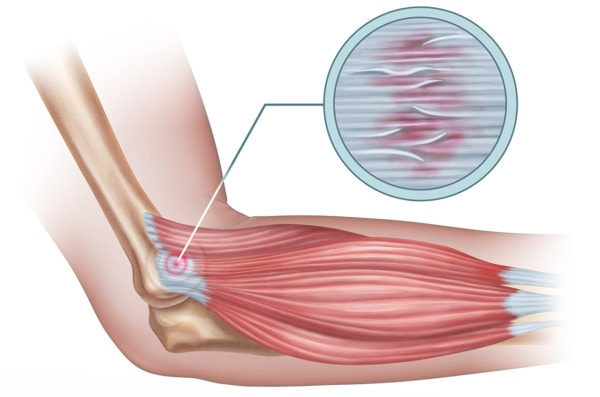Real Surgery No Better than Fake Surgery for Tennis Elbow?
This is yet another in my ongoing series showing that most elective orthopedic surgery is useless. Meaning that while most of the American public with an injury and pain believe that they are just one surgery away from “fixing” their problem, the research on orthopedic surgery procedures continues to show that for the most part, it’s invasive and ineffective. The latest entry in that ongoing deflation of the ortho bubble was just published on tennis elbow. Let’s review.

The damaged tendons in tennis elbow. Andrea Danti/Shutterstock
Lateral Epicondylitis, or Tennis Elbow
Lateral epicondylitis is commonly known as elbow tendinitis or tennis elbow. The lateral epicondyle is a bony prominence at the elbow end of the humerus bone (the upper-arm bone). It’s on the outer side of the elbow. Tendons attach to this bone and form into the extensor carpi radialis brevis (ECRB), a medical-terminology mouthful, but these are simply a group of muscles in the forearm. Tennis elbow occurs, studies have shown, as a result of degeneration of these and other tendons.
While lateral epicondylitis has traditionally been associated with overuse motions of the elbow, such as what a tennis player would experience, we more commonly see this issue suddenly develop in middle-aged people with a nerve issue, such as a pinched nerve, in their neck. A nerve problem in the neck (with neck pain or without) can result in tightness in the forearm muscles, which causes them to put stress on the tendons at the lateral epicondyle in the elbow. This can cause tennis elbow. To learn more about how that happens, please see my video below:
Conservative measures, such as rest, ice, heat, bracing, physical therapy, and so on can be very effective for tennis elbow, but healing can take time. Surgery may seem like a faster and more effective alternative for healing tennis elbow, especially for an athlete who needs to get back in the game or a construction worker, for example, who needs to get back on the job. However, a new study suggests otherwise. Let’s take a look.
Real Surgery No Better than Fake Surgery for Tennis Elbow
The purpose of the new study was to compare tennis elbow surgery (specifically excising the affected part of the extensor carpi radialis brevis) to a placebo surgery (a sham surgery). This randomized controlled trial randomly placed 26 patients into either the tennis elbow surgery group or the placebo surgery group (only a skin incision with exposure of the affected tendon). Pain, function, range of motion and other outcomes were measured at six months as well as at two and a half years post surgery.
The results? In both groups, similar improvements were reported in all measured areas. Researchers concluded that there were no significant differences between the surgery group and the fake surgery group at any point and that no benefits were seen with surgery compared to the placebo surgery for tennis elbow.
In other words, real surgery was no better than fake surgery for tennis elbow, meaning, in time, these patients would have realized these improvements without the surgery. So why are we performing tennis elbow surgery when there’s really no need for it?
What About Injections for Tennis Elbow?
When conservative measures fail or aren’t working fast enough, physicians may shift their treatment focus for tennis elbow to steroid injections, but these are bad news as studies have shown steroids can damage tendon cells and intensify tendinitis, break down cartilage, increase the risk of fractures, and much, much more. So while they might provide some short-term relief, over time, they’re making matters much worse.
Platelet-rich plasma (PRP) injections, on the other hand, have been shown to provide effective long-term improvements in patients with tennis elbow, and one study found them to be more effective than steroids. In addition, when the neck is the true source of the problem (i.e., a nerve issue in the part of the cervical spine that supplies the elbow), the neck may need to be treated concurrently with the elbow. While we saw in the study above that surgery for tennis elbow may be pointless anyway, it’s certainly clear that surgery isn’t going to provide an effective solution for tennis elbow when the problem is generated in the neck.
The upshot? The ortho surgery balloon created by decades of invasive procedures invented on the fly is popping quickly as study after study shows that these procedures are ineffective. How much longer before insurers catch on? Your guess is as good as mine, but patients need to stand up and say “enough.”

If you have questions or comments about this blog post, please email us at [email protected]
NOTE: This blog post provides general information to help the reader better understand regenerative medicine, musculoskeletal health, and related subjects. All content provided in this blog, website, or any linked materials, including text, graphics, images, patient profiles, outcomes, and information, are not intended and should not be considered or used as a substitute for medical advice, diagnosis, or treatment. Please always consult with a professional and certified healthcare provider to discuss if a treatment is right for you.